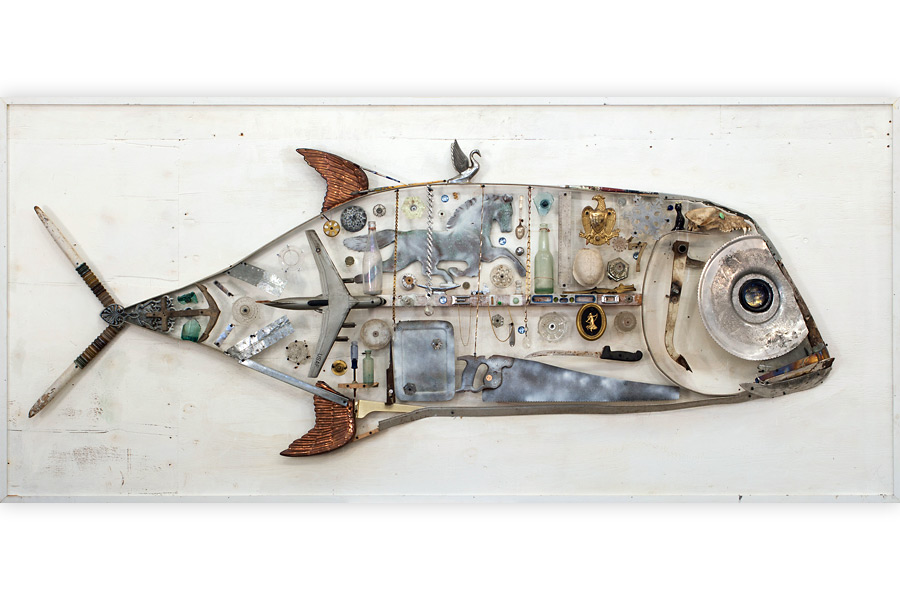Work on Monday: "Untitled" (Ulua) by Mica Marder

This week, Work on Monday looks at an untitled work by artist and Springs native Mica Marder. This large assemblage of found objects represents an ulua fish, or giant trevally, a fairly large Hawaiian game fish from the jack family, but more than that, it’s the physical embodiment of Marder’s world.
Each Work on Monday column looks at one piece of art related to the East End, usually by a Hamptons or North Fork artist, living or dead, created in any kind of medium. Join the conversation by posting your thoughts in the comments section below and email suggestions for a future Work on Monday here.
“Untitled” (Ulua)
Mica Marder (b. 1980, Springs, NY)
Mixed media on wood
54.5 x 121 inches, 2015
Like many of the works featured in this column, Marder’s fish is strong and worthwhile formally, but a longer look reveals more than the already compelling whole. It takes the viewer, pardon the pun, to deeper places. Like any good and authentically created collage or assemblage, the piece is more than the sum of its parts. In fact, its parts, the many bits and pieces collected from Marder’s daily life and the areas in and around his studio, help form a picture of the creator as much as they do his creation.
The assembled objects—old bottles, glass doorknobs, tools, a rust-spotted fillet knife, paintbrushes, vintage toys, discarded costume jewelry, a fishing lure, boat and car parts, broken furniture, brass numbers, a sun-bleached turtle shell and the skull of some sort of fox or dog, among other items—are fun to pick out of the fish’s form and identify. This is a collection of lives and moments long past, insignificant to most and likely forgotten.
It is also—as can be seen from the circa 1948 Packard swan hood ornament, which goes for a tidy sum on eBay—a bold statement that the value of good art transcends the material things Marder uses to create it. There can be little doubt, if a $10,000 gold bar was the perfect addition to his next assemblage, Marder would sacrifice it for this higher purpose.
While representing a fin, an eye, a tail, each object has a history—a story—all its own, whether it’s the fox’s life and death, the many hands that once gripped and turned the doorknobs or held the tarnished spoon, the home that wore the brass number seven and the lives lived within it, or even the factory that created and filled each bottle, the shop where it was sold and the man or woman who eventually drank its contents.
By putting these objects together in such an unforgettable and brilliantly executed form, Marder honors the past and asks his viewer to consider those things that on their own might not earn a second glance. In doing so, he affects the way we appreciate the world around us, because it is covered in these vestiges of bygone days and the men and women who lived through them. And that is no small feat.
To see more work by Mica Marder, visit Silas Marder Gallery (120 Snake Hollow Road) in Bridgehampton, 631-702-2306, silasmarder.com.



